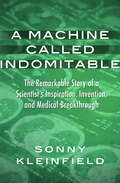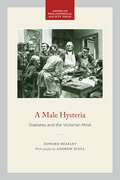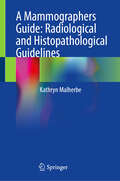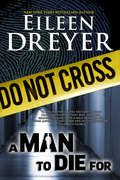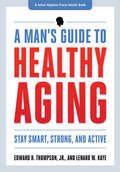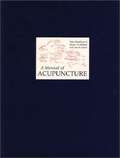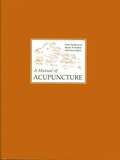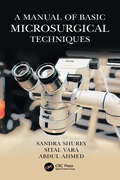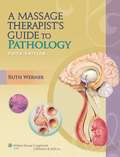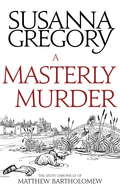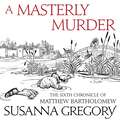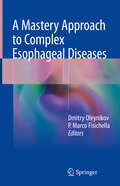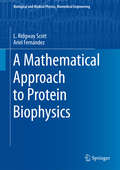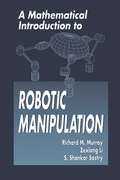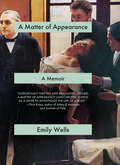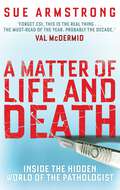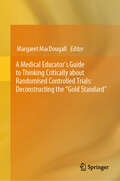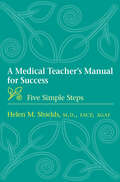- Table View
- List View
A Machine Called Indomitable: The Remarkable Story of a Scientist's Inspiration, Invention, and Medical Breakthrough
by Sonny KleinfieldThe true story of the doctor who invented the MRI: &“A fascinating account of how a significant medical development came about&” (The New York Times). Dr. Raymond Damadian was plagued with a mysterious and persistent stomach pain, yet physicians assured him that they could find nothing wrong. To find the answer to his ailment, Damadian would spend the ensuing twelve years building a machine that would change medicine. Nuclear magnetic resonance scanning, now called magnetic resonance imaging (MRI), was a revolution: a safe means to determine the makeup of every cell in the human body, distinguishing healthy cells from sick. Although Damadian&’s ideas were met with skepticism and outright opposition from the medical community, this machine would go on to save the lives of millions by diagnosing disease while effective treatment was still possible. In short, it was a medical miracle. The story of Damadian&’s quest—battling skeptical peers, money troubles, and more with an intensity approaching obsession—is one of the great legends of medical research. Sonny Kleinfield, acclaimed reporter and author, captures Damadian&’s remarkable triumph against the odds with compassion and a keen eye. A Machine Called Indomitable is scientific storytelling at its finest.
A Magnetic Laser Scanner for Endoscopic Microsurgery (Springer Theses)
by Alperen AcemogluThis book focuses on the design, development, and characterization of a compact magnetic laser scanner for microsurgical applications. In addition, it proposes a laser incision depth controller to be used in soft tissue microsurgeries.The use of laser scanners in soft tissue microsurgery results in high quality ablations with minimal thermal damage to surrounding tissue. However, current scanner technologies for microsurgery are limited to free-beam lasers, which require direct line-of-sight to the surgical site, from outside the patient. Developing compact laser micromanipulation systems is crucial to introducing laser-scanning capabilities in hard-to-reach surgical sites, e.g., vocal cords.In this book, the design and fabrication of a magnetically actuated endoscopic laser scanner have been shown, one that introduces high-speed laser scanning for high quality, non-contact tissue ablations in narrow workspaces. Static and dynamic characterization of the system, its teleoperation through a tablet device, and its control modelling for automated trajectory executions have been shown using a fabricated and assembled prototype. Following this, the book discusses how the laser position and velocity control capabilities of the scanner can be used to design a laser incision depth controller to assist surgeons during operations.
A Male Hysteria: Diabetes and the Victorian Mind
by Edward BeasleyA history of diabetes science and the experience of diabetics in the nineteenth-century EnglandA Male Hysteria examines both the science of diabetes in nineteenth-century England and the testimony of Victorian diabetics. What could be known about diabetes given the science of the day? And what did new models of diabetes mean for the treatment and self-image of diabetics?Ideas about diabetes were revolutionized in 1849 by the great French physiologist Claude Bernard. After he made rabbits diabetic by pricking their brains, diabetes in England came to be thought of as neurological, even psychological in origin. British diabetics (often men) were prevented from working or becoming excited, treated in the same manner as women who were diagnosed with hysteria. Meanwhile, discoveries in thermodynamics were applied to diabetics and menstruating women. People were assumed to be closed systems, wasting energy that couldn't be replenished. Thus, diabetics had to stay still if they wanted to live and women had to stay away from education to have the energy to produce children.Some people resisted these hysterical views. As no brain lesion was ever found in deceased diabetics, even after decades of searching, the animal model of the disease no longer seemed to apply to humans. Some diabetic patients also resisted the hysterical picture, including medical professionals—both men and women—who refused to slow down as the new treatment regimen was mandated. Likewise, physicians at spas noted that walking long distances seemed to help diabetics.A Male Hysteria journeys through nineteenth-century diabetes science and the lives of diabetics. It examines how science can go wrong when models from one area of inquiry are too excitedly applied to another. It also demonstrates the persistence of the psychological stereotype of diabetics as nervous and overworked in the United Kingdom—long after medical attention turned to the pancreas and the role of insulin.
A Mammographers Guide: Radiological and Histopathological Guidelines
by Kathryn MalherbeThis comprehensive mammography textbook brings numerous benefits and fills a significant gap in medical diagnostics. It provides a detailed, structured approach to breast imaging, making it a unique and indispensable resource for healthcare professionals. Firstly, this textbook stands out for its uniqueness. Unlike many existing resources, it offers a step-by-step guide to the standard imaging protocol used in breast imaging, ensuring optimal imaging quality. This includes detailed explanations of the cranial-caudal (CC) and mediolateral oblique (MLO) views, which are the primary modalities for detecting potential pathological findings. By adhering to these standardized protocols, mammographers can improve the accuracy of their diagnoses and reduce the risk of missed malignancies. The textbook is meticulously structured to serve both novice and experienced mammographers. It begins with foundational concepts, such as the importance of comparing current imaging with previous studies to identify new densities. It then progresses to more advanced topics, including the differentiation between benign and malignant conditions. The detailed descriptions of imaging criteria for benign conditions, such as being oval, well-rounded, well-encapsulated, large, bilateral, and unchanged from prior imaging, provide mammographers with the knowledge needed to make informed decisions about patient care. Intended primarily for mammographers, this textbook serves as a valuable resource for medical students, technologists, and other healthcare professionals involved in breast imaging. By providing a comprehensive guide to breast imaging, it addresses a critical gap in the field. The clear, structured content ensures that readers can apply the latest imaging techniques and criteria to improve diagnostic accuracy and patient outcomes. In summary, the aims and objectives of creating this mammography textbook are to provide a unique, structured resource for mammographers, ensuring they have the tools and knowledge necessary to enhance their practice and improve patient care.
A Man to Die For: Medical Thriller
by Eileen Dreyer"A wicked prescription guaranteed to give you sleepless nights." ~Nora RobertsSt. Louis Trauma nurse Casey McDonough thinks her life is interesting enough. Her best friend still drops acid, her ex-husband is a cross-dressing psychiatrist, and her mother has turned the third floor of the family home into the Chapel of Eternal Vigilance.Then, things begin to really go wrong when OB/Gyn Dr. Dale Hunsacker arrives. Handsome, wealthy and charismatic, the good doctor is enchanting the patients of the St. Louis hospital. But, Cassy believes he is a serial killer. And the only person who takes her seriously, is Hunsacker himself.Caught in a spiral of suspicion and intimidation, Casey approaches ex-Marine, ex-Jesuit homicide sergeant Jack Scanlan for help. All she has are hunches for proof, but she'll do anything to stop the monster walking the halls of her hospital."Eileen Dreyer creates the sort of skin-crawling suspense that will leave readers looking with a wild and wary eye upon anyone at the other end of a stethoscope." ~Elizabeth GeorgePublisher's Note: As a former trauma nurse, Eileen Dreyer combines her real-world medical knowledge and superb story-telling to bring readers a series of uniquely plotted, spine-tingling, medical mysteries. Fans of Tami Hoag, Elizabeth George, Nora Roberts as well as John Lutz, Michael Crichton and Patricia Cornwell will enjoy these well-crafted medical thrillers. OTHER MEDICAL SUSPENSE/THRILLERS by Eileen Dreyer:Nothing PersonalBrain DeadBad MedicineIf Looks Could Kill
A Man to be Trusted
by Gill SandersonSue McCain, newly qualified as a midwife, found her work satisfying. But she carried too much baggage to be completely at ease socially these days. That didn't matter to the Obs & Gynae Registrar, Dan Webster. He wanted to get to know her, and he clearly wasn't going to allow himself to befrozen out! He even persuaded her to help with a concert he was organising for the hospital. But it brought her past and her present face to face, and only Dan's support and love helped her cope ...
A Man to be Trusted: A Gripping Medical Romance
by Gill Sanderson<p>Sue McCain, newly qualified as a midwife, found her work satisfying. But she carried too much baggage to be completely at ease socially these days. That didn't matter to the Obs & Gynae Registrar, Dan Webster, though. He wanted to get to know her, and he was determined not to be frozen out!<p> <p>He even managed to persuade her to help with a concert he was organising for the hospital. However, in doing so, it brought her painful past and her present face to face. Could Dan's support and love be the only thing to help her cope?<p>
A Man's Guide to Healthy Aging: Stay Smart, Strong, and Active (A Johns Hopkins Press Health Book)
by Edward H. Thompson Jr. Lenard W. KayeExplores all aspects of health as men reach middle age and beyond.As they reach middle age, most men begin looking forward to "what's next." They gear up to experience renewed productivity and purpose and are more conscious of their health. A Man's Guide to Healthy Aging is an authoritative resource for them, and for older men, as well. In collaboration with a variety of medical experts, the authors provide a comprehensive guide to healthy aging from a man's perspective.Edward H. Thompson, Jr., and Lenard W. Kaye—a medical sociologist and a gerontologist and social worker—offer invaluable information in four parts: • "Managing Our Lives" describes the actions men can take to stay healthy. Here is information about how to eat well, reduce stress, and stay active for better overall health.• "Mind and Body" considers how physical health and state of mind are connected. It explores sleep, drug and alcohol use, spirituality, and attitudes about appearance—and explains how all of these factors affect mental health. • "Bodily Health" examines how body systems function and what changes may occur as men age. It covers the body from head to toe and reviews how to manage chronic diseases such as cancer, diabetes, and heart conditions. • "Living with Others" shows the importance of interacting with friends and family. Topics include sexual intimacy, friendship, and caregiving, as well as how men can make the best decisions about end-of-life issues for themselves and their loved ones. Refuting the ageist stereotype that men spend their later years "winding down," this book will help men reinvent themselves once, twice, or more—by managing their health, creating new careers, and contributing their skills and experiences to their communities.
A Manifesto for Mental Health: Why We Need a Revolution in Mental Health Care
by Peter KindermanA Manifesto for Mental Health presents a radically new and distinctive outlook that critically examines the dominant ‘disease-model’ of mental health care. Incorporating the latest findings from both biological neuroscience and research into the social determinants of psychological problems, Peter Kinderman offers a contemporary, biopsychosocial, alternative. He warns that the way we care for people with mental health problems is creating a hidden human rights emergency and he proposes a new vision for the future of health organisations across the globe. The book highlights persuasive evidence that our mental health and wellbeing depend largely on the society in which we live, on the things happen to us, and on how we learn to make sense of and respond to those events. Kinderman proposes a rejection of invalid diagnostic labels, practical help rather than medication, and a recognition that distress is usually an understandable human response to life's challenges. Offering a serious critique of establishment thinking, A Manifesto for Mental Health provides a well-crafted demonstration of how, with scientific rigour and empathy, a revolution in mental health care is not only highly desirable, it is also entirely achievable.
A Manual Of Acupuncture
by Peter Deadman Mazin Al-KhafajiThis book is deeply rooted in the classical tradition of Chinese acupuncture. The practice of acupuncture has grown spectacularly in the Western world over the last three or four decades. During the early period of this expansion there was scanty source material available. China was firmly closed to access by students of Chinese medicine, few textbooks were available in translation, and even fewer translators were skilled in the difficult task of rendering the terminology of Chinese medicine into other languages.
A Manual of Acupuncture
by Kevin Baker Peter Deadman Mazin Al-KhafajiOnce in a great while an extraordinary book is published that sets an entirely new standard in its field. A Manual of Acupuncture, published by Journal of Chinese Medicine Publications, is just such a book. Painstakingly researched over many years by Peter Deadman, editor-in-chief of The Journal of Chinese Medicine, and colleagues Mazin Al-Khafaji and Kevin Baker, this book has become the primary reference in the West for the study of acupuncture points and channels. With the subtle use of color to illustrate the acupuncture points and anatomical features, the new second edition of A Manual of Acupuncture is even more attractive and user-friendly than the first. Introductory chapters describe and illustrate the channels and collaterals, the various categories of points, and methods of selection, location, and needling. Ensuing chapters present each of the points of the 14 channels as well as the extra (miscellaneous) points, identified by their English and pinyin names, and Chinese characters. Each point is located in accordance with the most exacting anatomical standards to be found in any Western textbook. For each point there is a dedicated drawing, followed by regional body drawings. The quality of the 500 drawings is far superior to those in any other TCM text. There are also practical pointers for finding and needling the points, and cautionary information about what to avoid. In addition to point indexes by their English and pinyin names, there is an index identifying every part of the body reached by each of the channels, and separate indexes of point indications listed according to both TCM and biomedical symptoms.
A Manual of Basic Microsurgical Techniques
by Abdul Ahmed Sandra Shurey Sital VaraA practical surgical manual providing a step-by-step guide to basic microsurgical techniques for the reconstruction of small vessels, nerves, and vas deferens. This also includes access to videos demonstrating core microsurgical techniques. Incorporating 40 years of experience gained by the teachers of the microvascular course at Northwick Park, the techniques described in this manual have trained generations of surgeons. Fully illustrated and with a clear, succinct text, this manual will enable the reader to master basic skills quickly and confidently. Microsurgery is not difficult, provided it is taught properly: There is no magic formula, but it must be learnt slowly, patiently and step by step. This valuable resource will be useful for surgeons in training and in practice and for research workers who are increasingly using microsurgical techniques in their experiments.
A Manual of Neonatal Intensive Care
by Janet M Rennie Giles KendallHighly Commended, BMA Medical Book Awards 2014The fifth edition of this highly successful and well-regarded book continues to provide those working in neonatal intensive care units with precise instructions on the diagnosis and management of common neonatal problems. This edition has been extensively updated and revised, while retaining the backgro
A Massage Therapist's Guide to Pathology
by Ruth WernerSet a solid foundation with the new edition of LWW''s bestselling pathology text for manual therapists! This cornerstone book of the massage curriculum is the most comprehensive, visually appealing, and respected title to cover the pathologies that massage therapists must be familiar with. In the fifth edition, Ruth Werner''s A Massage Therapist''s Guide to Pathology the focus on not only explaining the disease, but also its applicability and indications in massage therapy This text offers detailed information on the etiology, signs, symptoms, and treatment of more than 500 diseases and conditions, and also helps students discover how massage therapy influences the healing process Organized by body system, the text features case histories in which people living and coping with many of the disease conditions covered in the text share their stories. Key Features · An enhanced art program, featuring illustrations that capture the reader''s attention and make difficult concepts easier to grasp · A new Conditions at a Glance appendix to provide concise information on an additional 34 diseases · There''s also a new table at the end of each disease condition summarizing the benefits, risks, and options for massage therapy · Case histories share stories of people living with conditions covered in the text to draw a real-world connection between the classroom and the clinic · Research literacy appendix addresses the need for evidence-based massage therapy · Compare and contrast charts present similar conditions side-by-side to help students discern the differences This book provides comprehensive, yet concise, information on the etiology, signs, symptoms, and standard treatment approaches for more than 500 diseases and conditions. At the end of each condition, a "Risks, Benefits, Options" table provides guidance on the implications for massage. For this 5th edition, the author has throroughly researched and updated each condition in the text. She has streamlined the information to focus on what is most useful to the massage therapy student, while maintaining the friendly and accessible style that this text is known for Included with each book is a code for access to a host of games, exercises, quizzes, videos, and animations, all developed or selected by the author.
A Masterly Murder: The Sixth Chronicle of Matthew Bartholomew (Chronicles of Matthew Bartholomew #6)
by Susanna GregoryThe sixth chronicle in the Matthew Bartholomew series. Michaelhouse is in uproar: Kenyngham the saintly but ageing Master has announced his retirement and with unseemly haste Runham arranges his own 'election' as his successor. Within days he has dismissed several members of staff, including the redoubtable laundress Agatha, and is making life so unpleasant for the scholars that even Matthew Bartholomew believes his future as physician and teacher at the college is untenable. But Matthew has many patients to divert his attention and Brother Michael, Proctor of the fledgling university, has some suspicious deaths to investigate, although they cannot help but notice that the new Master has commissioned a flurry of building work. Then Runham himself is murdered and, although mourned by none, Matthew and Michael know they have to solve the mystery before any more damage is done to their beloved Michaelhouse.'A first-rate treat for mystery lovers' (Historical Novels Review)'Susanna Gregory has an extraordinary ability to conjure up a strong sense of time and place' (Choice)
A Masterly Murder: The Sixth Chronicle of Matthew Bartholomew (Chronicles of Matthew Bartholomew #9)
by Susanna GregoryMichaelhouse is in uproar: Kenyngham the saintly but ageing Master has announced his retirement and with unseemly haste Runham arranges his own 'election' as his successor. Within days he has dismissed several members of staff, including the redoubtable laundress Agatha, and is making life so unpleasant for the scholars that even Matthew Bartholomew believes his future as physician and teacher at the college is untenable. But Matthew has many patients to divert his attention and Brother Michael, Proctor of the fledgling university, has some suspicious deaths to investigate, although they cannot help but notice that the new Master has commissioned a flurry of building work. Then Runham himself is murdered and, although mourned by none, Matthew and Michael know they have to solve the mystery before any more damage is done to their beloved Michaelhouse.
A Mastery Approach to Complex Esophageal Diseases
by P. Marco Fisichella Dmitry OleynikovThis book brings together all stages of the diagnosis and treatment of all complex esophageal disorders in a single volume. A special emphasis is given to emerging procedures in laparoscopy, thoracoscopy, and endoscopy. Stages of operative approaches with relevant technical considerations are outlined in an easily understandable manner. The text is illustrated throughout by easy to understand illustration line graphs that depict fundamental anatomic or technical principles. Each chapter includes a summary of the current management strategy for the disease process, and a review of current innovations surrounding the topic. The book is applicable to physicians in both the surgical disciplines and in gastroenterology, as well as residents and fellows in this area.
A Mathematical Approach to Protein Biophysics (Biological and Medical Physics, Biomedical Engineering)
by L. Ridgway Scott Ariel FernándezThis book explores quantitative aspects of protein biophysics and attempts to delineate certain rules of molecular behavior that make atomic scale objects behave in a digital way. This book will help readers to understand how certain biological systems involving proteins function as digital information systems despite the fact that underlying processes are analog in nature. The in-depth explanation of proteins from a quantitative point of view and the variety of level of exercises (including physical experiments) at the end of each chapter will appeal to graduate and senior undergraduate students in mathematics, computer science, mechanical engineering, and physics, wanting to learn about the biophysics of proteins. L. Ridgway Scott has been Professor of Computer Science and of Mathematics at the University of Chicago since 1998, and the Louis Block Professor since 2001. He obtained a B. S. degree (Magna Cum Laude) from Tulane University in 1969 and a PhD degree in Mathematics from the Massachusetts Institute of Technology in 1973. Professor Scott has published over 130 papers and three books, extending over biophysics, parallel computing and fundamental computing aspects of structural mechanics, fluid dynamics, nuclear engineering, and computational chemistry. Ariel Fern#65533;ndez (born Ariel Fern#65533;ndez Stigliano) is an Argentinian-American physical chemist and mathematician. He obtained his Ph. D. degree in Chemical Physics from Yale University and held the Karl F. Hasselmann Endowed Chair Professorship in Bioengineering at Rice University. He is currently involved in research and entrepreneurial activities at various consultancy firms. Ariel Fern#65533;ndez authored three books on translational medicine and biophysics, and published 360 papers in professional journals. He holds two patents in the field of biotechnology.
A Mathematical Introduction to Robotic Manipulation
by Richard M. Murray S. Shankar Sastry Zexiang LiA Mathematical Introduction to Robotic Manipulation presents a mathematical formulation of the kinematics, dynamics, and control of robot manipulators. It uses an elegant set of mathematical tools that emphasizes the geometry of robot motion and allows a large class of robotic manipulation problems to be analyzed within a unified framework. The foundation of the book is a derivation of robot kinematics using the product of the exponentials formula. The authors explore the kinematics of open-chain manipulators and multifingered robot hands, present an analysis of the dynamics and control of robot systems, discuss the specification and control of internal forces and internal motions, and address the implications of the nonholonomic nature of rolling contact are addressed, as well. The wealth of information, numerous examples, and exercises make A Mathematical Introduction to Robotic Manipulation valuable as both a reference for robotics researchers and a text for students in advanced robotics courses.
A Matter of Appearance: A Memoir
by Emily WellsA dazzling memoir of chronic illness that explores the fraught intersection between pain, language, and gender, by a debut author.Emily Wells spent her childhood dancing through intense pain she assumed was normal for a ballerina pushing her body to its limits. For years, no doctor could tell Wells what was wrong with her, or they told her it was all in her head.In A Matter of Appearance, Wells traces her journey as she tries to understand and define the chronic pain she has lived with all her life. She draws on the critical works of Freud, Sontag, and others to explore the intersection between gender, pain, and language, and she traces a direct line from the &“hysteria patients&” at the Salpêtrière Hospital in nineteenth-century Paris to the contemporary New Age healers in Los Angeles, her stomping ground. At the crux of Wells&’ literary project is the dilemma of how to diagnose an experience that is both private and public, subjective and quantifiable, and how to express all this in words.&“Gorgeously written and brilliantly argued, A Matter of Appearance uses chronic illness as a lever to investigate the life of a body. It&’s complex, inconclusive, and incredibly clear-eyed. Moving fluidly between histories of psychoanalysis, desire, ambition, pathology, Wells reminds us of the liminal state we all live in between sickness and health.&”—Chris Kraus, author of Aliens & Anorexia and Summer of Hate
A Matter of Gravity
by Howard Scott Phyllis Aronoff Hélène VachonA Matter of Gravity is a playful and touching treatment of illness and tragedy, in which an enigmatic manuscript brings together two disparate male characters. Black humor and compassion brilliantly illuminate their tragic encounter.Hélène Vachon is the author of two novels and more than twenty works of children's literature. Her books have been nominated for many prizes, including the Governor General's Literary Award and the Mr. Christie's Book Award.Howard Scott is a Montreal literary translator who specializes in the genres of fiction and nonfiction.Phyllis Aronoff is former president of the Literary Translators' Association of Canada.
A Matter of Life and Death: Inside the Hidden World of the Pathologist
by Sue ArmstrongTrue tales of microscopic detective work that catches killers both human and pathogen: &“More fascinating than fiction. Forget CSI, this is the real thing&” (Val McDermid). A Matter of Life and Death profiles some of the world&’s most eminent and pioneering pathologists. This is a hidden world, yet one we will all inevitably encounter at some time in our lives, for pathology lies at the cornerstone of modern medicine. It is pathologists who are responsible for recognizing new diseases such as AIDS, SARS or bird flu, and for diagnosing which cancer a patient is suffering from. Beyond this, it is pathologists who must explain the cause of death at the autopsy table. A Matter of Life and Death tells fascinating stories of mysterious illnesses and miraculous scientific breakthroughs. But it is also crammed full of extraordinary characters - from the forensic anthropologist with his own Body Farm in Tennessee to the doctor who had a heart-and-lung transplant and ended up using her own lungs for research. &“If you&’re interested in criminal investigation, this is the must-read of the year. Probably of the decade.&” —Val McDermid, author of Insidious Intent
A Medical Educator's Guide to Thinking Critically about Randomised Controlled Trials: Deconstructing the "Gold Standard"
by Margaret MacDougallDrawing on the statistical and philosophical expertise of its authors, this book is designed to improve understanding and use of randomised controlled trials (RCTs) among health professionals. It is intended for use primarily by medical educators involved in teaching statistics and evidence-based medicine (EBM) to medical students, junior doctors and other health professionals. However, each of the chapters serves a wider range of interests, including the practical needs of physicians in interpreting research evidence to support clinical decision making and the teaching needs of philosophers of medicine who want to more fully appreciate how RCTs work in practice and provide engaging examples for their students. Rather than compete with the proliferating methodological literature on RCT designs, this book focuses on cultivating a healthy skepticism among developing health professionals to support critical appraisal of their own and published work on RCTs at a fundamental level, including through a more informed understanding of the place of subgroup analyses in sound statistical inference. Management of the positive predictive value in the statistical analysis of RCT findings is included as an important topic for contemporary medical curricula. In comparing RCTs with non-randomised studies, a search for empirical evidence for the superiority of RCTs is initiated, pointing to the need for further work to confirm what form this evidence should take.Medical educators will find a wealth of reasons to encourage their students to think more critically about how the RCT operates in practice as a gold standard.
A Medical History of Skin: Scratching the Surface (Studies for the Society for the Social History of Medicine #10)
by Kevin Patrick SienaDiseases affecting the skin have tended to provoke a response of particular horror in society. This collection of essays uses case studies to chart the medical history of skin from the eighteenth to the twentieth century.
A Medical Teacher's Manual for Success: Five Simple Steps
by Helen M. ShieldsAlthough most medical school faculty members are required to teach, the standard medical school curriculum doesn't tell them how to do it well. This book does.An award-winning clinician-teacher, Helen M. Shields has spent her career training future doctors, researchers, and medical school instructors. Here she shares classroom-tested methods for developing, implementing, and evaluating effective curricula for medical students. Shields's five steps emphasize• extensive behind-the-scenes preparation, with a focus on visualizing both one's own performance and the desired student feedback• clear and logical presentations that match the material being taught• controlled exploration of topics through prepared questions and management of group dynamics• reinforcement of important concepts throughout the teaching session• a five-minute summary of take-home pointsShields's easy-to-follow guide discusses what teachers should do—and what they should not do. She provides pertinent beginning-of-chapter questions, sample teaching materials, tips for last-minute assignments, and other pearls of wisdom. Shields also describes the methods of dynamic and effective instructors, offers a step-by-step approach to preparation and presentation, and relates proven ways to address a variety of expected and unexpected situations.Innovative and practical, A Medical Teacher's Manual for Success is an essential resource for medical school faculty members who want to teach well.
